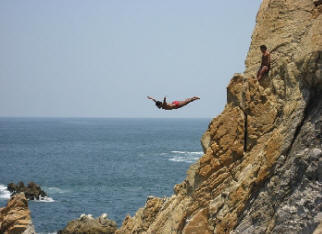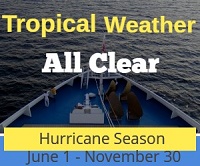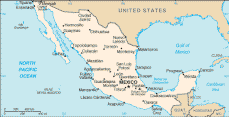Acapulco Cruise Ship Destination Profile
Cruise Ship Port of Call information like Port News, Weather, Transportation Options, Things to Do and See, Area Events, Medical Care, Crime and Safety Review
Venice
Get to know our slice of Paradise - located on the SW Coast of Fl.
Attractions
Beaches
Canoe/Kayak
Boat Launches
Boat Charters
Fishing Charter
Fishing Piers
Historical Sites
Golf
Parks
Hotels
Relocate
Venice Map
Mexican Riviera Destination Ports
Acapulco
Cabo San Lucas
Cancun
Ensenada
Mazatlan
Manzanillo
Puerto Vallarta
Western Caribbean Destination Ports
Cozumel
Costa Maya
Falmouth
Grand Cayman
Mexico
Montego Bay
Ocho Rios
Playa del Carmen
Progreso/Merida
Roatan
Roseau
San Tomas
Acapulco Neighborhoods
The Golden Zone - main town area with nightlife and hotels
Las Brisas - Hills of Acapulco
Caleta - Historic Acapulco
The Diamond Zone - The newest area of Acapulco
Pie de la Cuesta - West of Town
Costa Azul - Residential neighborhood
Earthquakes
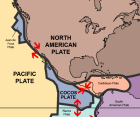 Situated
atop three of the large tectonic plates that constitute the Earth's surface,
Mexico is one of the most seismically active regions on earth. The motion of
these plates causes earthquakes and volcanic activity.
Situated
atop three of the large tectonic plates that constitute the Earth's surface,
Mexico is one of the most seismically active regions on earth. The motion of
these plates causes earthquakes and volcanic activity.
More about Mexico seismic activity
Need to Know
Personal Safety
Downtown Acapulco and surrounding areas have seen a significant increase in narcotics-related violence in the last year. Incidents have included daylight gunfights and murders of law enforcement personnel and some have resulted in the deaths of innocent bystanders. Due to the unpredictable nature of this violence, you should exercise extreme caution when visiting downtown Acapulco. To reduce risks, tourists should not visit the downtown area at night and should remain in clearly identifiable tourist areas. In general, the popular tourist area of Diamante just south of the city has not been affected by the increasing violence. See recent news
Area Medical Care
Adequate medical care can be found in major cities. Excellent health facilities are available in Mexico City, but training and availability of emergency responders may be below U.S. standards. Care in more remote areas is limited. Standards of medical training, patient care and business practices vary greatly among medical facilities in beach resorts throughout Mexico.
Note: In recent years, some U.S. citizens have complained that certain health-care facilities in beach resorts have taken advantage of them by overcharging or providing unnecessary medical care. Elective medical procedures may be less expensive than in the United States. However, visitors are cautioned that facilities may lack access to sufficient emergency support.
Drinking Water
In many areas in Mexico, tap water is unsafe and should be avoided. Bottled water and beverages are safe although visitors should be aware that many restaurants and hotels serve tap water unless bottled water is specifically requested. Ice may also come from tap water and should be used with caution. Visitors should exercise caution when buying food or beverages from street vendors.
Swimming
The quality of water along some beaches in or near Acapulco or other large coastal communities may be unsafe for swimming because of contamination.
Swimming in contaminated water may cause diarrhea and/or other illnesses.
Mexican government agencies monitor water quality in public beach areas but their standards and sampling techniques may differ from those in the United States.
Getting around
For tourists, the Acapulco city government has established a system of yellow buses with Acapulco! painted on the side of them.
These buses are not for tourists only, but are certainly the nicest and most uniform of the bus systems. These buses travel the tourist section of Acapulco, driving up and down the coast.
Area Events
Acapulco French Festival
The annual French Festival takes place throughout Acapulco city and offers a multitude of events that cement cultural links between Mexico and France. April annual event
Day of the Virgin of Guadalupe Cliff Diving
Freestyle cliff divers gracefully launch themselves off La Quebrada every year on 12 December, the Day of the Virgin of Guadalupe. La Quebrada, Acapulco
Mexican Independence Day Sep annual event
Celebrations across the country mark Mexico's gaining of independence from Spain in 1810, starting on the evening of the 15 September and carrying on to the next day, a public holiday
Revolution Day
The whole of Mexico reaches fever pitch with Revolution Day celebrations, Aniversario de la Revolución Mexicana. Nov annual event
Day of the Dead
Mexico's famous commemoration of the dead - el día de los muertos - is both a joyous and touching celebration. The living fondly remember their ancestors with street festivals, parades, and more. Annual event Nov 1
ports > destinations > Acapulco
Acapulco, Mexico
| Medical Services | Getting Around |
| Personal Safety | Things to Do |
| Weather | Area Events |
| Hurricanes | Port Entry |
Photo: Acapulco Bay
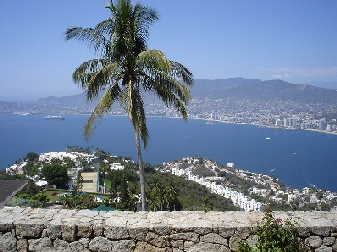
Acapulco is a city and major sea port in the state of Guerrero on the Pacific coast of Mexico, 190 mi southwest from Mexico City. Acapulco is located on a deep, semi-circular bay, built on a narrow strip of low ground, scarcely half a mile (800 m) wide, between the shoreline and the lofty mountains that encircle the bay to the north and east.
The climate is tropical, with warm to hot temperatures year-round. Precipitation is heavily concentrated in summer, while winter is mostly dry and sunny. A passage through the mountains, called Abra de San Nicolas, has been constructed, and it allows cooling sea breezes to reach the city.
Good to Know
The area is full of vendors wanting to sell you something (including illegal drugs) and folks with blue shirts offering services from A - Z. Most of the offers are scams so we recommend travelers avoid strangers, and don't stray off the beaten path. Utilize cruise company excursion opportunities as a way to experience the area.
Port of Acapulco
The Acapulco Cruise Terminal is located downtown east of the Zona Dorado and walking distance to the main Zocalo.
Time Zone
CST (UTC/GMT - 6)
Map Coordinates
16.51°N, 99.55°W
Average Temperatures
Water: Summer - Winter
Air: 90° Summer -88° Winter
News
Daily Police Beat for Acapulco at: elsoldeacapulco.com
10 murder victims found scattered around areas of Acapulco
Posted May 29, 2012
Police found the mutilated bodies of at least ten victims scattered around the tourist destination of Acapulco according to a report by the Latin America Herald. Gang warfare is being attributed to the deaths. The La Barredora drug gang and the Cartel Independiente de Acapulco have been fighting for control of the resort city for more than one year according to the report.
7.4 Earthquake SE of Acapulco
Posted March 20, 2012
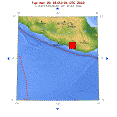 A
7.4 magnitude earthquake, located about 100 miles WSW of Oaxaca,
Mexico, and 115 miles east of Acapulco, struck around 12 p.m. CDT today. The epicenter
located at 16.662°N, 98.188°W, had a depth of approximately 12.4 miles. Strong
aftershocks averaging 5.0 have been recorded all day. No fatalities and no reports of
any major
damage.
A
7.4 magnitude earthquake, located about 100 miles WSW of Oaxaca,
Mexico, and 115 miles east of Acapulco, struck around 12 p.m. CDT today. The epicenter
located at 16.662°N, 98.188°W, had a depth of approximately 12.4 miles. Strong
aftershocks averaging 5.0 have been recorded all day. No fatalities and no reports of
any major
damage.
Source: US Geological Survey
Things to do and see
Playa Caleta and Caletilla
Two of Acapulco's traditional beaches and favorites of locals and tourists alike.
Caltea and Caletilla form a fairly small beach front, which fills up every morning with locals, Mexican tourists, and a smattering of Europeans, Canadians, and Americans. This is no longer the beach of the celebrities and of the rich. It has loads of local color. The nearby hotels (in Acapulco’s “Traditional Zone”) were once the best in town, but more recently they serve tourists on a budget. Some of them still provide an excellent vacation experience. This beach represents a pleasant exposure, not only to the sun and sea, but to the local culture as well.
Playa Tlacopanocha
This busy beach is located right at the end of the Malecón (town pier) and across from the Maritime terminal. It's great place to watch the cruise ships pull in or take off, and it presents a great chance to take in some authentic Mexican culture.
Hornitos Beach
Hornitos Beach is sometimes called “Papagayo Beach” because it is right in front of Parque Papagayo. The restaurants and vendors cater to Mexican families and tourists. As a result, it is a place where the kids love to run around, and it has more than the usual amount of litter. It is also a hangout for taxis and tourist police, by the base of the main flag pole.
Hornos & Tamarindos Beaches
Playa Hornos and its neighbor, Playa Tamarindos, are closer to Acapulco’s Traditional Zone than Playa Hornitos, and they offer a bit more to the tourist. There are rows of large coconut palms and several good beach restaurants. The sand is cool and clean. The water is somewhat calmer than in the beaches farther to the east in the Golden Zone. Playa Hornos and Playa Tamarindos appeal to many locals and visitors from Mexico City, but several international tourists come here as a quieter alternative to the more hectic Condesa and Icacos beaches. Playa Tamarindos extends for about 700 meters down the beach from the Hotel Las Hamacas to approximately where the Hotel Acabay is located.
Icacos Beach
Located in the "Golden Zone" near the La Palapa Hotel. The sand and the water is very clean, and the restaurants and beach bars are very welcoming. Plenty of activities including waverunner rentals, parasailing, hot air balloon rides and more. Popular beach for Spring Breakers. This beach serves mainly the hotels and condominiums in Costa Azul.
Condesa Beach
Totally touristy beach. Shops, restaurants, hotels, vendors, services, rentals etc. Located in the center of Acapulco Bay between La Gran Plaza and the Bungy Jump. Hornos Beach is located to the north and Icacos Beach is located to the south.
Puerto Marques
Picturesque beach with calm waters located about a 20-minute taxi ride away. A dash of seafood restaurants located nearby. Favorite of the locals.
Revolcadero Beach
Located in Acapulco's Diamond Zone near the airport, past Puerto Marques. Playa Revolcadero (literally, “tumbler beach”) is a long, wide stretch of sandy strand on the open ocean by the Hotel Fairmont Acapulco Princess, one of Acapulco's most luxurious hotels. (It is the one that resembles a big Mayan pyramid). On weekends in the late morning, the beach fills up with Acapulco's chic crowd, who are trying to get a tan and get over a hangover at the same time. Here the beautiful, elegant and well-to-do come to play, run, lie in the sun or relax under the canopies and in the cabanas. This is also a favorite beach for swimming. Playa Revolcadero always has waves of a fairly good size, but seldom are they dangerously strong. If the red flags are out, however, be sure to heed them. Revolcadero Beach usually has far less undertow [resaca, contracorriente] than the beaches in the Golden Zone.
Pie de la Cuesta
Considerable drive (30-40 minutes by taxi) to get to this beach get-away. Large waves and strong current; not recommended for swimming. Located to the west of town.Pie de la Cuesta is miles and miles of yellow sand beach. You can literally start walking early in the morning and not reach the end until the afternoon. The beach is great, but the ocean here can be fierce. Pie de la Cuesta beach runs parallel to the Coyoca Lagoon. A variety of restaurants and places to stay welcome you at the entrance to the beach. They spread out much more as you move along up to the end where the lagoon meets the sea. The beach is an excellent choice for those who love peace and quiet or who enjoy relaxing in a totally natural tropical setting. The sunsets here are so breathtaking that Pie de la Cuesta could be nichnamed "sunset beach." (Some people think that this is the Spanish translation of its name; however, "Pie de la Cuesta” means “Foot of the Slope,” where the high ridge around Acapulco comes down to the sea.)
Roqueta
Acapulco's best known island Roqueta, is a great attraction which is typically reached by glass-bottomed motor boats (enabling a clear view of the sea bottom). Playa Roqueta and Playa Marin are a pair of quiet, rustic beaches located on the Isla de la Roqueta off the coast of the traditional section of Acapulco (Acapulco Nautical). The only access is by boat. Water taxis are available at Playa Caleta on the mainland. Playa Roqueta is the island's principal beach. Playa Marin is a small, remote, undeveloped beach, which can only be reached by taking a small hike from Playa Roqueta.
Playa Larga
Playa Larga, or in English "long beach," is a very long stretch of beach on the way to Barra Vieja. It's about half a dozen miles from Puerto Marques and begins shortly after Playa Revolcadero. Here one can find campsites, a sea turtle hatchery, and a few places to stay. The beaches are usually very quiet, with few others around, and no beach vendors. Unlike Acapulco's other beaches, Playa Large does not have a view backward to the mountains behind. Access is best accomplished by car. (The taxi ride is long and expensive, and it will be hard to find one for the trip back.) Allow 30-45 minutes of travel time from the center of Acapulco. Parking is available. In theory it is free; however, as elsewhere in Mexico, the “car watchers” who freelance there require a small fee for their services, and nobody would ever be so imprudent as to decline them.
Cliff Diving
The La Quebrada Cliff Divers are a group of professional high divers, based in Acapulco, Mexico. They perform daily shows for the public, which involve diving 45 metres (148 ft) from the cliffs of La Quebrada into the sea below. During the night, they often hold torches while diving. Acapulco cliff diving was regularly featured on weekend sports television programming in the United States during the 1960s to 70's when film stunt man Ray Austin made the dive. Although cliff diving at La Quebrada had taken place for many years, it was not until 1934 that the La Quebrada Cliff Divers was formed. The World Cliff Diving Championships are also held at La Quebrada.
